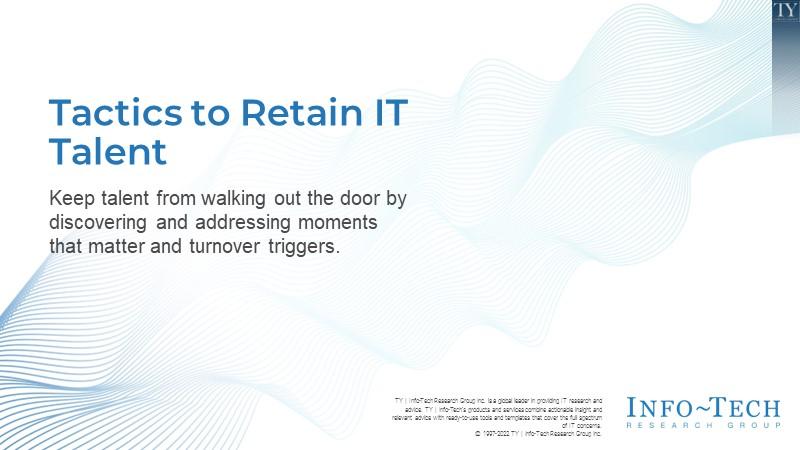
Tactics to Retain IT Talent
- Regrettable turnover is impacting organizational productivity and leading to significant costs associated with employee departures and the recruitment required to replace them.
- Many organizations focus on increasing engagement to improve retention, but this approach doesn’t address the entire problem.
Our Advice
Critical Insight
- Engagement surveys mask the volatility of the employee experience and hide the reason why individual employees leave. You must also talk to employees to understand the moments that matter and engage managers to understand turnover triggers.
Impact and Result
- Build the case for creating retention plans by leveraging employee data and feedback to identify the key reasons for turnover that need to be addressed.
- Target employee segments and work with management to develop solutions to retain top talent.
Tactics to Retain IT Talent Research & Tools
Besides the small introduction, subscribers and consulting clients within this management domain have access to:
1. Tactics to Retain IT Talent Storyboard – Use this storyboard to develop a targeted talent retention plan to retain top and core talent in the organization.
Integrate data from exit surveys and interviews, engagement surveys, and stay interviews to understand the most commonly cited reasons for employee departure in order to select and prioritize tactics that improve retention. This blueprint will help you identify reasons for regrettable turnover, select solutions, and create an action plan.
- Tactics to Retain IT Talent Storyboard
2. Retention Plan Workbook – Capture key information in one place as you work through the process to assess and prioritize solutions.
Use this tool to document and analyze turnover data to find suitable retention solutions.
- Retention Plan Workbook
3. Stay Interview Guide – Managers will use this guide to conduct regular stay interviews with employees to anticipate and address turnover triggers.
The Stay Interview Guide helps managers conduct interviews with current employees, enabling the manager to understand the employee's current engagement level, satisfaction with current role and responsibilities, suggestions for potential improvements, and intent to stay with the organization.
- Stay Interview Guide
4. IT Retention Solutions Catalog – Use this catalog to select and prioritize retention solutions across the employee lifecycle.
Review best-practice solutions to identify those that are most suitable to your organizational culture and employee needs. Use the IT Retention Solutions Catalog to explore a variety of methods to improve retention, understand their use cases, and determine stakeholder responsibilities.
- IT Retention Solutions Catalog
Workshop: Tactics to Retain IT Talent
Workshops offer an easy way to accelerate your project. If you are unable to do the project yourself, and a Guided Implementation isn't enough, we offer low-cost delivery of our project workshops. We take you through every phase of your project and ensure that you have a roadmap in place to complete your project successfully.
1 Identify Reasons for Regrettable Turnover
The Purpose
Identify the main drivers of turnover at the organization.
Key Benefits Achieved
Find out what to explore during focus groups.
Activities
1.1 Review data to determine why employees join, stay, and leave.
1.2 Identify common themes.
1.3 Prepare for focus groups.
Outputs
List of common themes/pain points recorded in the Retention Plan Workbook.
2 Conduct Focus Groups
The Purpose
Conduct focus groups to explore retention drivers.
Key Benefits Achieved
Explore identified themes.
Activities
2.1 Conduct four 1-hour focus groups with the employee segment(s) identified in the pre-workshop activities.
2.2 Info-Tech facilitators independently analyze results of focus groups and group results by theme.
Outputs
Focus group feedback.
Focus group feedback analyzed and organized by themes.
3 Identify Needs and Retention Initiatives
The Purpose
Home in on employee needs that are a priority.
Key Benefits Achieved
A list of initiatives to address the identified needs
Activities
3.1 Create an empathy map to identify needs.
3.2 Shortlist retention initiatives.
Outputs
Employee needs and shortlist of initiatives to address them.
4 Prepare to Communicate and Launch
The Purpose
Prepare to launch your retention initiatives.
Key Benefits Achieved
A clear action plan for implementing your retention initiatives.
Activities
4.1 Select retention initiatives.
4.2 Determine goals and metrics.
4.3 Plan stakeholder communication.
4.4 Build a high-level action plan.
Outputs
Finalized list of retention initiatives.
Goals and associated metrics recorded in the Retention Plan Workbook.
Further reading
Tactics to Retain IT Talent
Keep talent from walking out the door by discovering and addressing moments that matter and turnover triggers.
Executive Summary
Your Challenge
Many organizations are facing an increase in voluntary turnover as low unemployment, a lack of skilled labor, and a rise in the number of vacant roles have given employees more employment choices.
Common Obstacles
Regrettable turnover is impacting organizational productivity and leading to significant costs associated with employee departures and the recruitment required to replace them.
Many organizations tackle retention from an engagement perspective: Increase engagement to improve retention. This approach doesn't consider the whole problem.
Info-Tech's Approach
Build the case for creating retention plans by leveraging employee data and feedback to identify the key reasons for turnover that need to be addressed.
Target employee segments and work with management to develop solutions to retain top talent.
Info-Tech Insight
Engagement surveys mask the volatility of the employee experience and hide the reason why individual employees leave. You must also talk to employees to understand the moments that matter and engage managers to understand turnover triggers.
This research addresses regrettable turnover
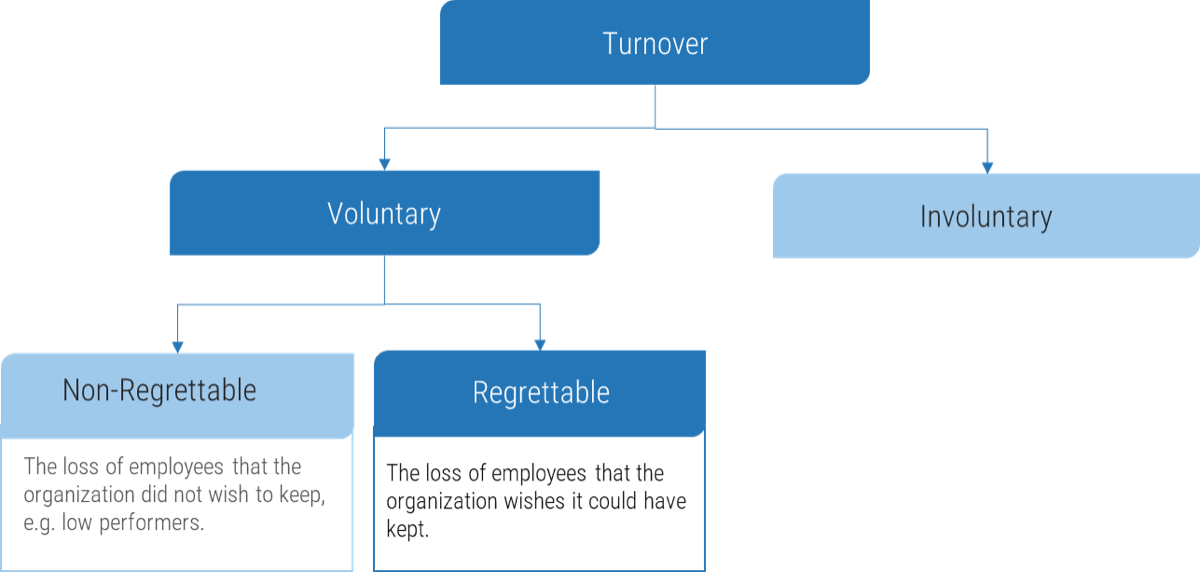
Low unemployment and rising voluntary turnover makes it critical to focus on retention
As the economy continues to recover from the pandemic, unemployment continues to trend downward even with a looming recession. This leaves more job openings vacant, making it easier for employees to job hop.

With more employees voluntarily choosing to leave jobs, it is more important than ever for organizations to identify key employees they want to retain and put plans in place to keep them.
Retention is a challenge for many organizations
The number of HR professionals citing retention/turnover as a top workforce management challenge is increasing, and it is now the second highest recruiting priority ("2020 Recruiter Nation Survey," Jobvite, 2020).
65% of employees believe they can find a better position elsewhere (Legaljobs, 2021). This is a challenge for organizations in that they need to find ways to ensure employees want to stay at the organization or they will lose them, which results in high turnover costs.
Executives and IT are making retention and turnover – two sides of the same coin – a priority because they cost organizations money.
- 87% of HR professionals cited retention/turnover as a critical and high priority for the next few years (TINYpulse, 2020).
- $630B The cost of voluntary turnover in the US (Work Institute, 2020).
- 66% of organizations consider employee retention to be important or very important to an organization (PayScale, 2019).
Improving retention leads to broad-reaching organizational benefits
Cost savings: the price of turnover as a percentage of salary
- 33% Improving retention can result in significant cost savings. A recent study found turnover costs, on average, to be around a third of an employee's annual salary (SHRM, 2019).
- 37.9% of employees leave their organization within the first year. Employees who leave within the first 90 days of being hired offer very little or no return on the investment made to hire them (Work Institute, 2020).
Improved performance
Employees with longer tenure have an increased understanding of an organization's policies and processes, which leads to increased productivity (Indeed, 2021).
Prevents a ripple effect
Turnover often ripples across a team or department, with employees following each other out of the organization (Mereo). Retaining even one individual can often have an impact across the organization.
Transfer of knowledge
Retaining key individuals allows them to pass it on to other employees through communities of practice, mentoring, or other knowledge-sharing activities.
Info-Tech Insight
Improving retention goes beyond cost savings: Employees who agree with the statement "I expect to be at this organization a year from now" are 71% more likely to put in extra hours and 32% more likely to accomplish more than what is expected of their role (McLean & Company Engagement Survey, 2021; N=77,170 and 97,326 respectively).
However, the traditional engagement-focused approach to retention is not enough
Employee engagement is a strong driver of retention, with only 25% of disengaged employees expecting to be at their organization a year from now compared to 92% of engaged employees (McLean & Company Engagement Survey, 2018-2021; N=117,307).
Average employee Net Promoter Score (eNPS)

Individual employee Net Promoter Scores (eNPS)
.png)
However, engagement surveys mask the volatility of the employee experience and hide the reason why individual employees leave.
This analysis of McLean & Company's engagement survey results shows that while an organization's average employee net promoter score (eNPS) stays relatively static, at an individual level there is a huge amount of volatility.
This demonstrates the need for an approach that is more capable of responding to or identifying employees' in-the-moment needs, which an annual engagement survey doesn't support.
Turnover triggers and moments that matter also have an impact on retention
Retention needs to be monitored throughout the employee lifecycle. To address the variety of issues that can appear, consider three main paths to turnover:
- Employee engagement – areas of low engagement.
- Turnover triggers that can quickly lead to departures.
- Moments that matter in the employee experience (EX).
Employee engagement
Engagement drivers are strong predictors of turnover.
Employees who are highly engaged are 3.6x more likely to believe they will be with the organization 12 months from now than disengaged employees (McLean & Company Engagement Survey, 2018-2021; N=117,307).
Turnover triggers
Turnover triggers are events that act as shocks or catalysts that quickly lead to an employee's departure.
Turnover triggers are a cause for voluntary turnover more often than accumulated issues (Lee et al.).
Moments that matter
Employee experience is the employee's perception of the accumulation of moments that matter within their employee lifecycle.
Retention rates increase from 21% to 44% when employees have positive experiences in the following categories: belonging, purpose, achievement, happiness, and vigor at work. (Workhuman, 2020).
While managers do not directly impact turnover, they do influence the three main paths to turnover
Research shows managers do not appear as one of the common reasons for employee turnover.
Top five most common reasons employees leave an organization (McLean & Company, Exit Survey, 2018-2021; N=107 to 141 companies,14,870 to 19,431 responses).
| Turnover factors | Rank |
|---|---|
| Opportunities for career advancement | 1 |
| Satisfaction with my role and responsibilities | 2 |
| Base pay | 3 |
| Opportunities for career-related skill development | 4 |
| The degree to which my skills were used in my job | 5 |
However, managers can still have a huge impact on the turnover of their team through each of the three main paths to turnover:
Employee engagement
Employees who believe their managers care about them as a person are 3.3x more likely to be engaged than those who do not (McLean & Company, 2021; N=105,186).
Turnover triggers
Managers who are involved with and aware of their staff can serve as an early warning system for triggers that lead to turnover too quickly to detect with data.
Moments that matter
Managers have a direct connection with each individual and can tailor the employee experience to meet the needs of the individuals who report to them.
Gallup has found that 52% of exiting employees say their manager could have done something to prevent them from leaving (Gallup, 2019). Do not discount the power of managers in anticipating and preventing regrettable turnover.
Addressing engagement, turnover triggers, and moments that matter is the key to retention
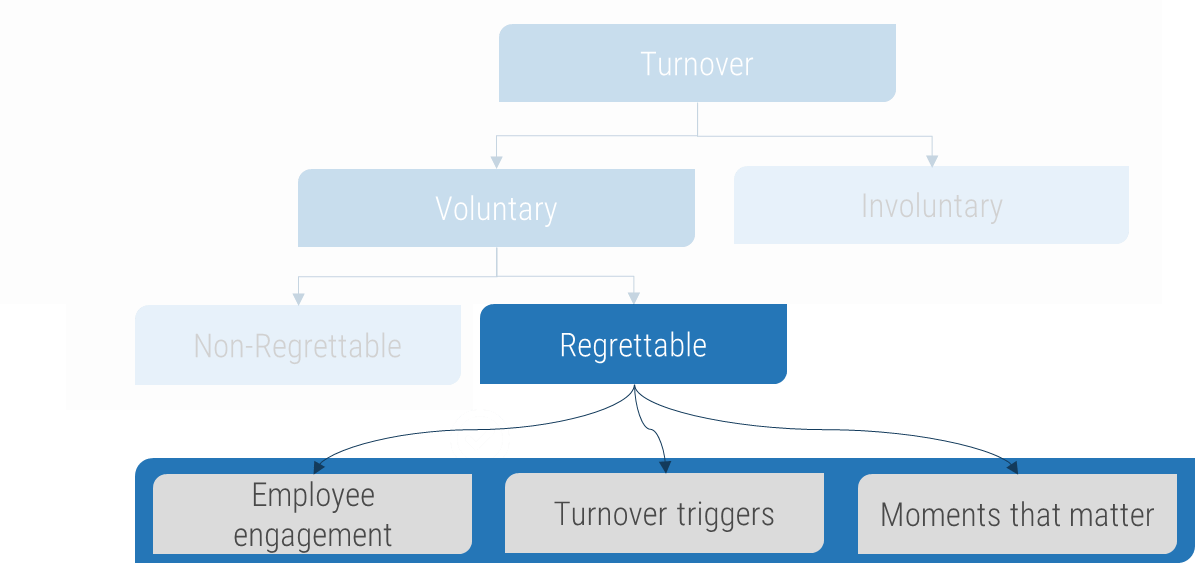
Info-Tech Insight
HR traditionally seeks to examine engagement levels when faced with retention challenges, but engagement is only a part of the full picture. You must also talk to employees to understand the moments that matter and engage managers to understand turnover triggers.
Follow Info-Tech's two-step process to create a retention plan
1. Identify Reasons for Regrettable Turnover
2. Select Solutions and Create an Action Plan
Step 1
Identify Reasons for Regrettable Turnover
After completing this step you will have:
- Analyzed and documented why employees join, stay, and leave your organization.
- Identified common themes and employee needs.
- Conducted employee focus groups and prioritized employee needs.
Step 1 focuses on analyzing existing data and validating it through focus groups
| Employee engagement | Employee engagement and moments that matter are easily tracked by data. Validating employee feedback data by speaking and empathizing with employees helps to uncover moments that matter. This step focuses on analyzing existing data and validating it through focus groups. |
|---|---|
| Engagement drivers such as compensation or working environment are strong predictors of turnover. | |
| Moments that matter | |
| Employee experience (EX) is the employee's perception of the accumulation of moments that matter with the organization. | |
| Turnover triggers | |
| Turnover triggers are events that act as shocks or catalysts that quickly lead to an employee's departure. | |
Turnover triggers | This step will not touch on turnover triggers. Instead, they will be discussed in step 2 in the context of the role of the manager in improving retention. |
Turnover triggers are events that act as shocks or catalysts that quickly lead to an employee's departure. |
Info-Tech Insight
IT managers often have insights into where and why retention is an issue through their day-to-day work. Gathering detailed quantitative and qualitative data provides credibility to these insights and is key to building a business case for action. Keep an open mind and allow the data to inform your gut feeling, not the other way around.
Gather data to better understand why employees join, stay, and leave
Start to gather and examine additional data to accurately identify the reason(s) for high turnover. Begin to uncover the story behind why these employees join, stay, and leave your organization through themes and trends that emerge.
Look for these icons throughout step 2. |
| Why do candidates join your organization? |
|---|---|---|
 | Why do employees stay with your organization? | |
 | Why do employees leave your organization? |
For more information on analysis, visualization, and storytelling with data, see Info-Tech's Start Making Data-Driven People Decisions blueprint.
Employee feedback data to look at includes:
Gather insights through:
- Focus groups
- Verbatim comments
- Exit interviews
- Using the employee value proposition (EVP) as a filter (does it resonate with the lived experience of employees?)
Prepare to draw themes and trends from employee data throughout step 1.
Uncover employee needs and reasons for turnover by analyzing employee feedback data.
- Look for trends (e.g. new hires join for career opportunities and leave for the same reason, or most departments have strong work-life balance scores in engagement data).
- Review if there are recurring issues being raised that may impact turnover.
- Group feedback to highlight themes (e.g. lack of understanding of EVP).
- Identify which key employee needs merit further investigation or information.
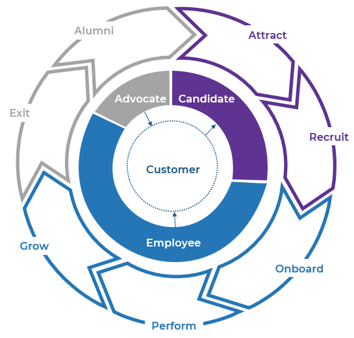
Classify where key employee needs fall within the employee lifecycle diagram in tab 2 of the Retention Plan Workbook. This will be used in step 2 to pinpoint and prioritize solutions.
Info-Tech Insight
The employee lifecycle is a valuable way to analyze and organize engagement pain points, moments that matter, and turnover triggers. It ensures that you consider the entirety of an employee's tenure and the different factors that lead to turnover.
Examine new hire data and begin to document emerging themes

While conducting a high-level analysis of new hire data, look for these three key themes impacting retention:
Issues or pain points that occurred during the hiring process.
Reasons why employees joined your organization.
The experience of their first 90 days. This can include their satisfaction with the onboarding process and their overall experience with the organization.
Themes will help to identify areas of strength and weakness organization-wide and within key segments. Document in tab 3 of the Retention Plan Workbook.
- Start by isolating the top reasons employees joined your organization. Ask:
- Do the reasons align with the benefits you associate with working at your organization?
- How might this impact your EVP?
- If you use a new hire survey, look at the results for the following questions:
- For which of the following reasons did you apply to this organization?
- For what reasons did you accept the job offer with this organization?
- then, examine other potential problem areas that may not be covered by your new hire survey, such as onboarding or the candidate experience during the hiring process.
- If you conduct a new hire survey, look at the results in the following sections:
- Candidate Experience
- Acclimatization
- Training and Development
- Defining Performance Expectations
- If you conduct a new hire survey, look at the results in the following sections:
Analyze engagement data to identify areas of strength that drive retention
Employees who are engaged are 3.6x more likely to believe they will be with the organization 12 months from now (McLean & Company Engagement Survey, 2018-2021; N=117,307). Given the strength of this relationship, it is essential to identify areas of strength to maintain and leverage.
- Look at the highest-performing drivers in your organization's employee engagement survey and drivers that fall into the "leverage" and "maintain" quadrants of the priority matrix.
- These drivers provide insight into what prompts broader groups of employees to stay.
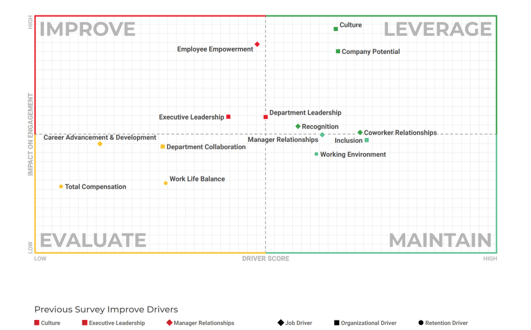
- Look into what efforts have been made to maintain programs, policies, and practices related to these drivers and ensure they are consistent across the entire organization.
- Document trends and themes related to engagement strengths in tab 2 of the Retention Plan Workbook.
If you use Info-Tech's Engagement Survey, look in detail at what are classified as "Retention Drivers": total compensation, working environment, and work-life balance.
Identify areas of weakness that drive turnover in your engagement data
- Look at the lowest-performing drivers in your organization's employee engagement survey and drivers that fall into the "improve" and "evaluate" quadrants of the priority matrix.
- These drivers provide insight into what pushes employees to leave the organization.
- Delve into organizational efforts that have been made to address issues with the programs, policies, and practices related to these drivers. Are there any projects underway to improve them? What are the barriers preventing improvements?
- Document trends and themes related to engagement weaknesses in tab 2 of the Retention Plan Workbook.
If you use a product other than Info-Tech's Engagement Survey, your results will look different. The key is to look at areas of weakness that emerge from the data.

If you use Info-Tech's Engagement Survey, look in detail at what are classified as "Retention Drivers": total compensation, working environment, and work-life balance.
Mine exit surveys to develop an integrated, holistic understanding of why employees leave
Conduct a high-level analysis of the data from your employee exit diagnostic. While analyzing this data, consider the following:
- What are the trends and quantitative data about why employees leave your organization that may illuminate employee needs or issues at specific points throughout the employee lifecycle?
- What are insights around your key segments? Data on key segments is easily sliced from exit survey results and can be used as a starting point for digging deeper into retention issues for specific groups.
- Exit surveys are an excellent starting point. However, it is valuable to validate the data gathered from an exit survey using exit interviews.
- Isolate results for key segments of employees to target with retention initiatives (e.g. by age group or by department).
- Identify data trends or patterns over time; for example, that compensation factors have been increasing in importance.
- Document trends and themes taken from the exit survey results in tab 2 of the Retention Plan Workbook.
If your organization conducts exit interviews, analyze the results alongside or in lieu of exit survey data.
Compare new hire data with exit data to identify patterns and insights
Determine if new hire expectations weren't met, prompting employees to leave your organization, to help identify where in the employee lifecycle issues driving turnover may be occurring.
- Look at your new hire data for the top reasons employees joined your organization.
- McLean & Company's New Hire Survey database shows that the top three reasons candidates accept job offers on average are:
- Career opportunities
- Nature of the job
- Development opportunities
- McLean & Company's New Hire Survey database shows that the top three reasons candidates accept job offers on average are:
- Next, look at your exit data and the top reasons employees left your organization.
- McLean & Company's Exit Survey database shows that the top three reasons employees leave on average are:
- Opportunities for career advancement
- Base pay
- Satisfaction with my role and responsibilities
- McLean & Company's Exit Survey database shows that the top three reasons employees leave on average are:
- Examine the results and ask:
- Is there a link between why employees join and leave the organization?
- Did they cite the same reasons for joining and for leaving?
- What do the results say about what your employees do and do not value about working at your organization?
- Document the resulting insights in tab 2 of the Retention Plan Workbook.
Example:
A result where employees are leaving for the same reason they're joining the organization could signal a disconnect between your organization's employee value proposition and the lived experience.
Revisit your employee value proposition to uncover misalignment
Your employee value proposition (EVP), formal or informal, communicates the value your organization can offer to prospective employees.
If your EVP is mismatched with the lived experience of your employees, new hires will be in for a surprise when they start their new job and find out it isn't what they were expecting.
Forty-six percent of respondents who left a job within 90 days of starting cited a mismatch of expectations about their role ("Job Seeker Nation Study 2020," Jobvite, 2020).
- Use the EVP as a filter through which you look at all your employee feedback data. It will help identify misalignment between the promised and the lived experience.
- If you have EVP documentation, start there. If not, go to your careers page and put yourself in the shoes of a candidate. Ask what the four elements of an EVP look like for candidates:
- Compensation and benefits
- Day-to-day job elements
- Working conditions
- Organizational elements
- Next, compare this to your own day-to-day experiences. Does it differ drastically? Are there any contradictions with the lived experience at your organization? Are there misleading statements or promises?
- Document any insights or patterns you uncover in tab 2 of the Retention Plan Workbook.
Conduct focus groups to examine themes
Through focus groups, explore the themes you have uncovered with employees to discover employee needs that are not being met. Addressing these employee needs will be a key aspect of your retention plan.
Identify employee groups who will participate in focus groups:
- Incorporate diverse perspectives (e.g. employees, managers, supervisors).
- Include employees from departments and demographics with strong and weak engagement for a full picture of how engagement impacts your employees.
- Invite boomerang employees to learn why an individual might return to your organization after leaving.
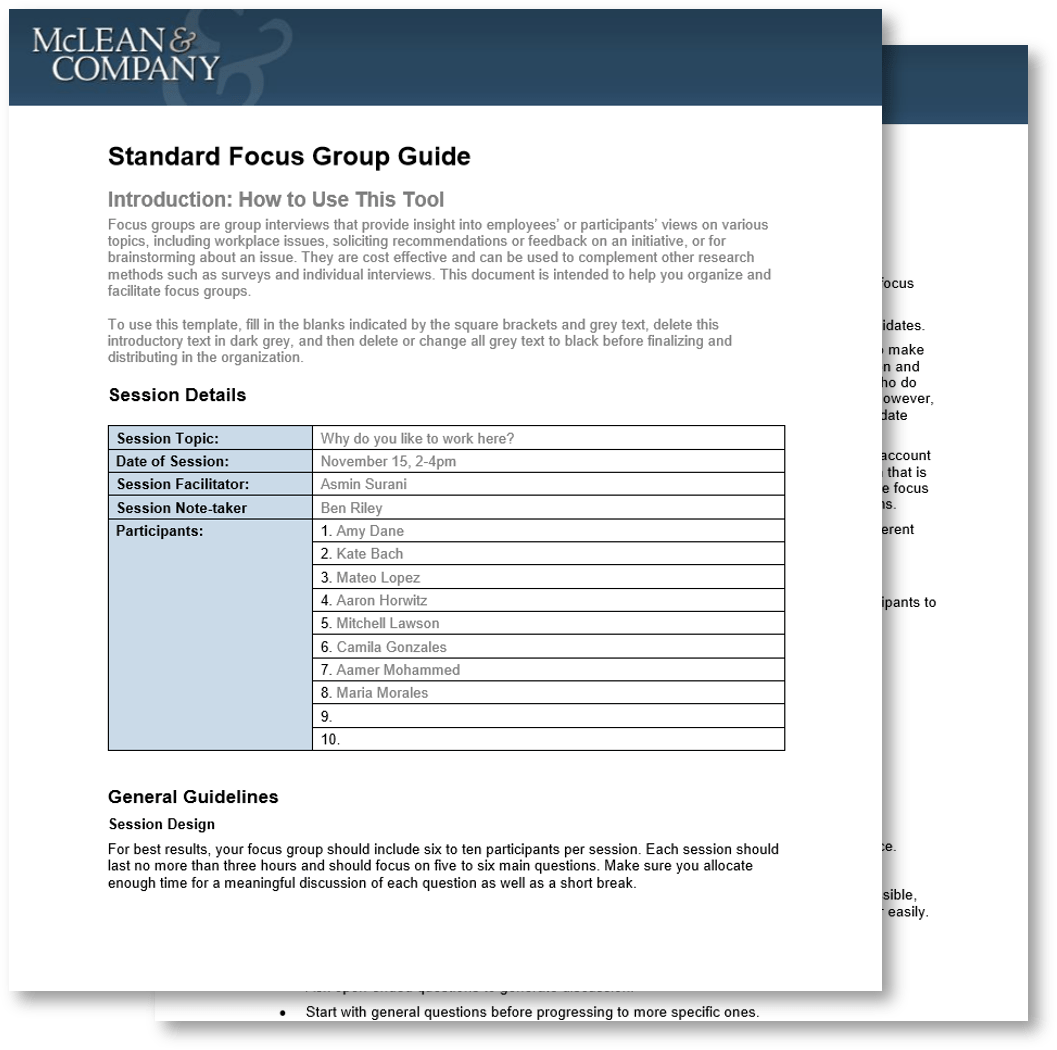
Customize Info-Tech's Standard Focus Group Guide based on the themes you have identified in tab 3 of the Retention Plan Workbook.
The goal of the focus group is to learn from employees and use this information to design or modify a process, system, or other solution that impacts retention.
Focus questions on the employees' personal experience from their perspective.
Key things to remember:
- It is vital for facilitators to be objective.
- Keep an open mind; no feelings are wrong.
- Beware of your own biases.
- Be open and share the reason for conducting the focus groups.
Info-Tech Insight
Maintaining an open dialogue with employees will help flesh out the context behind the data you've gathered and allow you to keep in mind that retention is about people first and foremost.
Empathize with employees to identify moments that matter
Look for discrepancies between what employees are saying and doing. | 1. Say "What words or quotes did the employee use?" | 3.Think "What might the employee be thinking?" | Record feelings and thoughts discussed, body language observed, tone of voice, and words used. Look for areas of negative emotion to determine the moments that matter that drive retention. |
2. Do "What actions or behavior did the employee demonstrate?" | 4. Feel "What might the employee be feeling?" | ||
Record them in tab 3 of the Retention Plan Workbook. | 5. Identify Needs | "Needs are verbs (activities or desires), not nouns (solutions)" | Synthesize focus group findings using Info-Tech's Empathy Map Template. |
|---|---|---|---|
6. Identify Insights | "Ask yourself, why?" |
(Based on Stanford d.school Empathy Map Method)
Distill employee needs into priority issues to address first
Take employee needs revealed by your data and focus groups and prioritize three to five needs.
Select a limited number of employee needs to develop solutions to ensure that the scope of the project is feasible and that the resources dedicated to this project are not stretched too thin. The remaining needs should not be ignored – act on them later.
Share the needs you identify with stakeholders so they can support prioritization and so you can confirm their buy-in and approval where necessary.
Ask yourself the following questions to determine your priority employee needs:
- Which needs will have the greatest impact on turnover?
- Which needs have the potential to be an easy fix or quick win?
- Which themes or trends came up repeatedly in different data sources?
- Which needs evoked particularly strong or negative emotions in the focus groups?

Step 2
Select Solutions and Create an Action Plan
After completing this step, you will have:
- Selected and prioritized solutions to address employee needs.
- Created a plan to launch stay interviews.
- Built an action plan to implement solutions.
Select IT-owned solutions and implement people leader–driven initiatives
Solutions
First, select and prioritize solutions to address employee needs identified in the previous step. These solutions will address reasons for turnover that influence employee engagement and moments that matter.
- Brainstorm solutions using the Retention Solutions Catalog as a starting point. Select a longlist of solutions to address your priority needs.
- Prioritize the longlist of solutions into a manageable number to act on.
People leaders
Next, create a plan to launch stay interviews to increase managers' accountability in improving retention. Managers will be critical to solving issues stemming from turnover triggers.
- Clarify the importance of harnessing the influence of people leaders in improving retention.
- Discover what might cause individual employees to leave through stay interviews.
- Increase trust in managers through training.
Action plan
Finally, create an action plan and present to senior leadership for approval.
Look for these icons in the top right of slides in this step.
Select solutions to employee needs, starting with the Retention Solutions Catalog
Based on the priority needs you have identified, use the Retention Solutions Catalog to review best-practice solutions for pain points associated with each stage of the lifecycle.
Use this tool as a starting point, adding to it and iterating based on your own experience and organizational culture and goals.
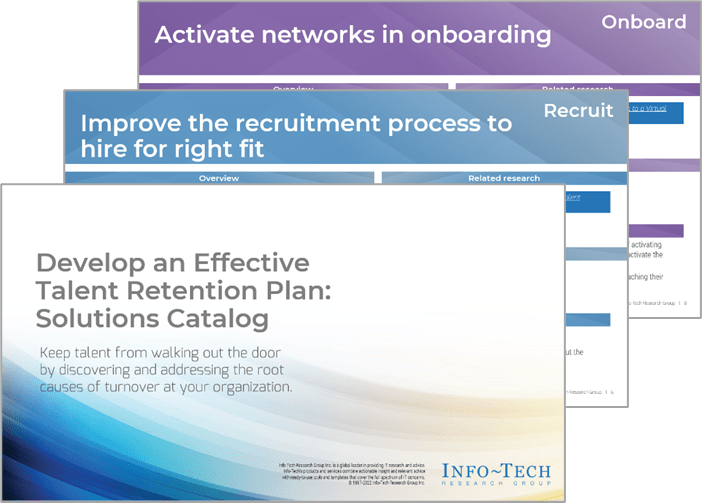
Use Info-Tech's Retention Solutions Catalog to start the brainstorming process and produce a shortlist of potential solutions that will be prioritized on the next slide.
Info-Tech Insight
Unless you have the good fortune of having only a few pain points, no single initiative will completely solve your retention issues. Combine one or two of these broad solutions with people-leader initiatives to ensure employee needs are addressed on an individual and an aggregate level.
Prioritize solutions to be implemented
Target efforts accordingly
Quick wins are high-impact, low-effort initiatives that will build traction and credibility within the organization.
Long-term initiatives require more time and need to be planned for accordingly but will still deliver a large impact. Review the planning horizon to determine how early these need to begin.
Re-evaluate low-impact and low-effort initiatives and identify ones that either support other higher impact initiatives or have the highest impact to gain traction and credibility. Look for low-hanging fruit.
Deprioritize initiatives that will take a high degree of effort to deliver lower-value results.
When assessing the impact of potential solutions, consider:
- How many critical segments or employees will this solution affect?
- Is the employee need it addresses critical, or did the solution encompass several themes in the data you analyzed?
- Will the success of this solution help build a case for further action?
- Will the solution address multiple employee needs?
Info-Tech Insight
It's better to master a few initiatives than under-deliver on many. Start with a few solutions that will have a measurable impact to build the case for further action in the future.
Solutions
| Low Impact | Medium Impact | Large Impact | |
|---|---|---|---|
| Large Effort |  | ||
| Medium Effort | |||
| Low Effort |
Use tab 3 of the Retention Plan Workbook to prioritize your shortlist of solutions.
Harness the influence of people leaders to improve employee retention
Leaders at all levels have a huge impact on employees.
Effective people leaders:
- Manage work distribution.
- Create a motivating work environment.
- Provide development opportunities.
- Ensure work is stimulating and challenging, but not overwhelming.
- Provide clear, actionable feedback.
- Recognize team member contributions.
- Develop positive relationships with their teams.
- Create a line of sight between what the employee is doing and what the organization's objectives are.
Support leaders in recommitting to their role as people managers through Learning & Development initiatives with particular emphasis on coaching and building trust.
For coaching training, see Info-Tech's Build a Better Manager: Team Essentials – Feedback and Coaching training deck.
For more information on supporting managers to become better people leaders, see Info-Tech's Build a Better Manager: Manage Your People blueprint.
"HR can't fix turnover. But leaders on the front line can."
– Richard P. Finnegan, CEO, C-Suite Analytics
Equip managers to conduct regular stay interviews to address turnover triggers
Managers often have the most visibility into their employees' personal and work lives and have a key opportunity to anticipate and address turnover triggers.
Stay interviews are an effective way of uncovering potential retention issues and allowing managers to act as an early warning system for turnover triggers.
Examples of common turnover triggers and potential manager responses:
- Moving, creating a long commute to the office.
- Through stay interviews, a manager can learn that a long commute is an issue and can help find workarounds such as flexible/remote work options.
- Not receiving an expected promotion.
- A trusted manager can anticipate issues stemming from this, discuss why the decision was made, and plan development opportunities for future openings.
Stay interview best practices
- Conducted by an employee's direct manager.
- Happen regularly as a part of an ongoing process.
- Based on the stay interview, managers produce a turnover forecast for each direct report.
- The method used by stay interview expert Richard P. Finnegan is simple: red for high risk, yellow for medium, and green for low.
- Provide managers with training and a rough script or list of questions to follow.
- Use and customize Info-Tech's Stay Interview Guide to provide a guide for managers on how to conduct a stay interview.
- Managers use the results to create an individualized retention action plan made up of concrete actions the manager and employee will take.
Sources: Richard P. Finnegan, CEO, C-Suite Analytics; SHRM
Build an action plan to implement the retention plan
For each initiative identified, map out timelines and actions that need to be taken.
When building actions and timelines:
- Refer to the priority needs you identified in tab 4 of the Retention Plan Workbook and ensure they are addressed first.
- Engage internal stakeholders who will be key to the development of the initiatives to ensure they have sufficient time to complete their deliverables.
- For example, if you conduct manager training, Learning & Development needs to be involved in the development and launch of the program.
- Include a date to revisit your baseline retention and engagement data in your project milestones.
- Designate process owners for new processes such as stay interviews.
Plan for stay interviews by determining:
- Whether stay interviews will be a requirement for all employees.
- How much flexibility managers will have with the process.
- How you will communicate the stay interview approach to managers.
- If manager training is required.
- How managers should record stay interview data and how you will collect this data from them as a way to monitor retention issues.
- For example, managers can share their turnover forecasts and action plans for each employee.
Be clear about manager accountabilities for initiatives they will own, such as stay interviews. Plan to communicate the goals and timelines managers will be asked to meet, such as when they must conduct interviews or their responsibility to follow up on action items that come from interviews.
Track project success to iterate and improve your solutions
Analyze measurements
- Regularly remeasure your engagement and retention levels to identify themes and trends that provide insights into program improvements.
- For example, look at the difference in manager relationship score to see if training has had an impact, or look at changes in critical segment turnover to calculate cost savings.
Revisit employee and manager feedback
- After three to six months, conduct additional surveys or focus groups to determine the success of your initiatives and opportunities for improvement. Tweak the program, including stay interviews, based on manager and employee feedback.
Iterate frequently
- Revisit your initiatives every two or three years to determine if a refresh is necessary to meet changing organizational and employee needs and to update your goals and targets.
Key insights
| Insight 1 | Insight 2 | Insight 3 |
|---|---|---|
Retention and turnover are two sides of the same coin. You can't fix retention without first understanding turnover. | Engagement surveys mask the volatility of the employee experience and hide the reason why individual employees leave. You must also talk to employees to understand the moments that matter and engage managers to understand turnover triggers. | Improving retention isn't just about lowering turnover, it's about discovering what healthy retention looks like for your organization. |
| Insight 4 | Insight 5 | Insight 6 |
HR professionals often have insights into where and why retention is an issue. Gathering detailed employee feedback data through surveys and focus groups provides credibility to these insights and is key to building a case for action. Keep an open mind and allow the data to inform your gut feeling, not the other way around. | Successful retention plans must be owned by both IT leaders and HR. | IT leaders often have the most visibility into their employees' personal and work lives and have a key opportunity to anticipate and address turnover triggers. Stay interviews help managers anticipate potential retention issues on their teams. |
Workshop Overview
Contact your account representative for more information.
workshops@infotech.com 1-888-670-8889
| Info-Tech Analysts | Pre-work | Post-work |
|---|---|---|
| Client Data Gathering and Planning | Implementation Supported Through Analyst Calls | |
1.1 Discuss participants, logistics, overview of workshop activities 1.2 Provide support to client for below activities through calls. | 2.1 Schedule follow-up calls to work through implementation of retention solutions based on identified needs. | |
| Client | 1.Gather results of engagement survey, new hire survey, exit survey, and any exit and stay interview feedback. 2.Gather and analyze turnover data. 3.Identify key employee segment(s) and identify and organize participants for focus groups. 4.Complete cost of turnover analysis. 5.Review turnover data and prioritize list of employee segments. | 1.Obtain senior leader approval to proceed with retention plan. 2.Finalize and implement retention solutions. 3.Prepare managers to conduct stay interviews. 4.Communicate next steps to stakeholders. |
Workshop Overview
Contact your account representative for more information.
workshops@infotech.com 1-888-670-8889
| Activities | Day 1 | Day 2 | Day 3 | Day 4 |
|---|---|---|---|---|
| Assess Current State | Conduct Focus Groups | Identify Needs and Retention Initiatives | Prepare to Communicate and Launch | |
1.1 Review data to determine why employees join, stay, and leave. 1.2 Identify common themes. 1.3 Prepare for focus groups. | 2.1 Conduct four 1-hour focus groups with the employee segment(s) identified in the pre-workshop activities.. 2.2 Info-Tech facilitators independently analyze results of focus groups and group results by theme. | 3.1 Create an empathy map to identify needs 3.2 Shortlist retention initiatives | 4.1 Select retention initiatives 4.2 Determine goals and metrics 4.3 Plan stakeholder communication4.4 Build a high-level action plan | |
| Deliverables | 1.List of common themes/pain points recorded in the Retention Plan Workbook 2.Plan for focus groups documented in the Focus Group Guide | 1.Focus group feedback 2.Focus group feedback analyzed and organized by themes | 1.Employee needs and shortlist of initiatives to address them | 1.Finalized list of retention initiatives |
Info-Tech offers various levels of support to best suit your needs
DIY Toolkit
“Our team has already made this critical project a priority, and we have the time and capability, but some guidance along the way would be helpful.”
Guided Implementation
“Our team knows that we need to fix a process, but we need assistance to determine where to focus. Some check-ins along the way would help keep us on track.”
Workshop
“We need to hit the ground running and get this project kicked off immediately. Our team has the ability to take this over once we get a framework and strategy in place.”
Consulting
“Our team does not have the time or the knowledge to take this project on. We need assistance through the entirety of this project.”
Diagnostics and consistent frameworks used throughout all four options
Research Contributors and Experts
Jeff Bonnell
VP HR
Info-Tech Research Group
Phillip Kotanidis
CHRO
Michael Garron Hospital
Michael McGuire
Director, Organizational Development
William Osler Health System
Dr. Iris Ware
Chief Learning Officer
City of Detroit
Richard P. Finnegan
CEO
C-Suite Analytics
Dr. Thomas Lee
Professor of Management
University of Washington
Jane Moughon
Specialist in increasing profits, reducing turnover, and maximizing human potential in manufacturing companies
Lisa Kaste
Former HR Director
Citco
Piyush Mathur
Head of Workforce Analytics
Johnson & Johnson
Gregory P. Smith
CEO
Chart Your Course
Works Cited
"17 Surprising Statistics about Employee Retention." TINYpulse, 8 Sept. 2020. Web.
"2020 Job Seeker Nation Study." Jobvite, April 2020. Web.
"2020 Recruiter Nation Survey." Jobvite, 2020. Web.
"2020 Retention Report: Insights on 2019 Turnover Trends, Reasons, Costs, & Recommendations." Work Institute, 2020. Web.
"25 Essential Productivity Statistics for 2021." TeamStage, 2021. Accessed 22 Jun. 2021.
Agovino, Theresa. "To Have and to Hold." SHRM, 23 Feb. 2019. Web.
"Civilian Unemployment Rate." Bureau of Labor Statistics, June 2020. Web.
Foreman, Paul. "The domino effect of chief sales officer turnover on salespeople." Mereo, 19 July 2018. Web.
"Gross Domestic Product." U.S. Bureau of Economic Analysis, 27 May 2021. Accessed 22 Jun. 2020.
Kinne, Aaron. "Back to Basics: What is Employee Experience?" Workhuman, 27August 2020. Accessed 21 Jun. 2021.
Lee, Thomas W, et al. "Managing employee retention and turnover with 21st century ideas." Organizational Dynamics, vol 47, no. 2, 2017, pp. 88-98. Web.
Lee, Thomas W. and Terence R. Mitchell. "Control Turnover by Understanding its Causes." The Blackwell Handbook of Principles of Organizational Behaviour. 2017. Print.
McFeely, Shane, and Ben Wigert. "This Fixable Problem Costs U.S. Businesses $1 Trillion." Gallup. 13 March 2019. Web.
"Table 18. Annual Quit rates by Industry and Region Not Seasonally Adjusted." Bureau of Labor Statistics. June 2021. Web.
"The 2019 Compensation Best Practices Report: Will They Stay or Will They Go? Employee Retention and Acquisition in an Uncertain Economy." PayScale. 2019. Web.
Vuleta, Branka. "30 Troubling Employee Retention Statistics." Legaljobs. 1 Feb. 2021. Web.
"What is a Tenured Employee? Top Benefits of Tenure and How to Stay Engaged as One." Indeed. 22 Feb. 2021. Accessed 22 Jun. 2021.